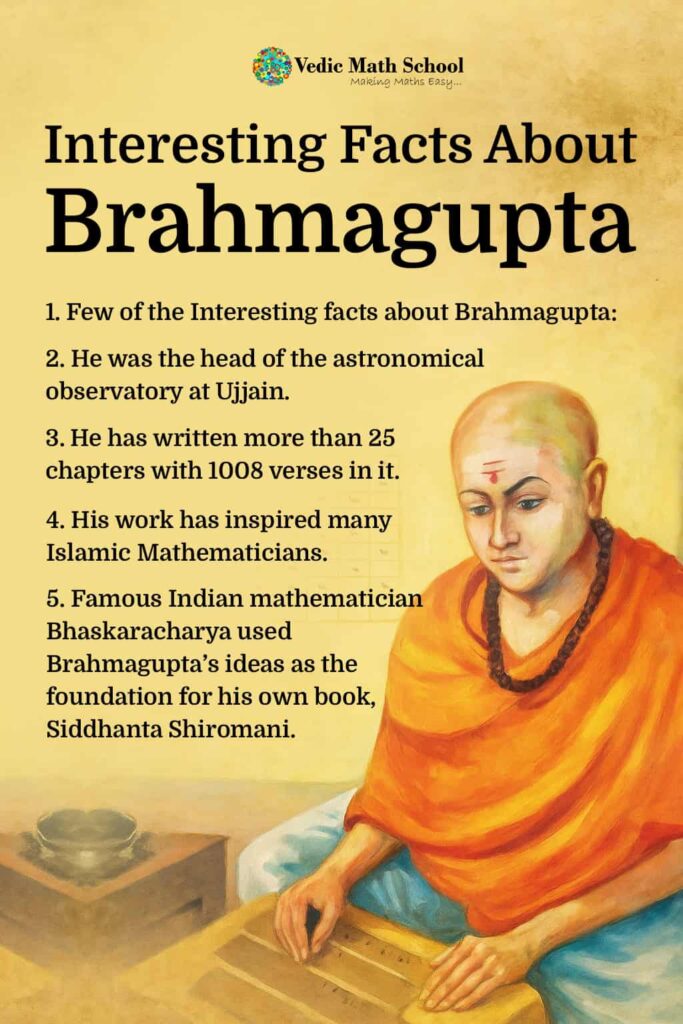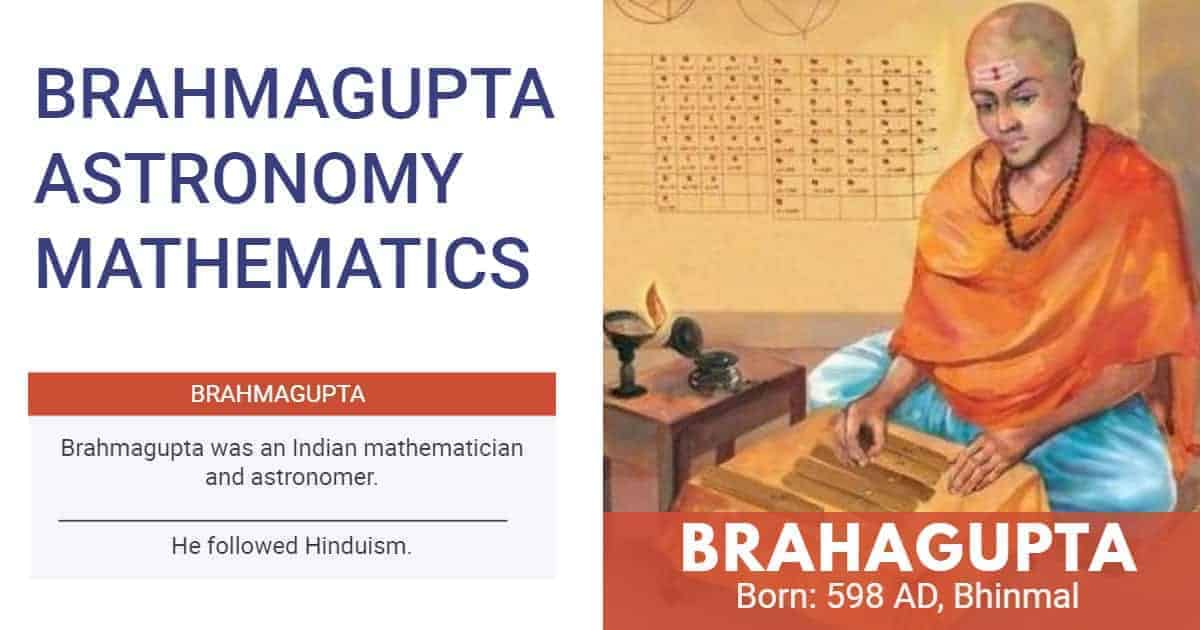Hi! Today’s spotlight is on Brahmagupta—the first to define zero as a number and establish rules for using it in calculations. A pioneer of algebra and astronomy, Brahmagupta’s legacy is remembered through centuries. Let’s learn more about Brahmagupta Mathematician!
Who is Brahmagupta?
Brahmagupta was one of the first and greatest mathematicians of his era.He was not only a master of astronomy, but he was also an expert in mathematics, in topics like algorithmics, algebra, trigonometry, and geometry.
Brahmagupta Biography:
Brahmagupta was born in 598 CE in Bhillamala, which is now Bhinmal (present-day Rajasthan). He followed Hinduism. Brahmagupta’s father, Jisnugupta, was an astrologer. Brahmagupta spent most of his childhood days in Bhillamala. Although Brahmagupta saw himself as an astronomer, he is mainly known today for his remarkable contributions to mathematics as mathematician Brahmagupta.
He once said that solving math problems was something he did for enjoyment. Some of his important works include Durkeamynarda (672), Khandakhadyaka (665), Brahmasphutasiddhanta (628), and Cadamakela (624). Among these, Brahmasphutasiddhanta, which means “The Corrected Treatise of Brahma,” is his most famous book.
He researched on astronomy and worked as an astronomer for Brahmapaksha school. It was one of the most famous Indian astronomy schools in India during that era. He studied Indian astronomy tradition, which is siddhanthas.
He studied the works of great Mathematicians and astronomers like Aryabhata I, Srisena, Vijayanandin Latadeva, Pradyumna, Simha, Varahamihira and Vishnuchandra.
It is believed that Brahmagupta was the head of an astronomical observatory in Ujjain, a well-known city in the Gurjar region during the time of Emperor Harshavardhana.
He wrote his famous book Brāhmasphuṭasiddhānta after closely observing the movements of planets when he was 30 years old, during the rule of King Vyaghramukh of the Chap dynasty, in the year 550 of the Shaka calendar.
Later, to do more research on astronomy he moved to Ujjain. Ujjain is said to be one of the best places to research astronomy.
At the age of 67, he wrote Khanda-khādyaka for his students. This book of his served as a practical manual of Indian Astronomy. Brahmagupta was awarded “Ganita Chakra Chudamani,” which means “The shining jewel among mathematicians.” He spent the last days of his life in Ujjain and died in 665 CE.
Now, in order to celebrate the mathematical brilliance of Mathematicians like Brahmagupta, we at Vedic Maths School, took initiatives to blend tradition with innovation to make math meaningful and accessible for learners across the globe. Therefore, we conducted 100+ workshops on Vedic Maths and Abacus globally and launched following courses:
- Vedic Mathematics Beginner to Advance Complete Course ( Live Class)
- Introduction To Vedic Maths [ Beginner Level]
- Vedic Maths Online Classes ( One to One )
- Vedic Mathematics Online Course for Twelfth Class (Live Class)
Brahmagupta Books
Few of the famous books written by Brahmagupta are:
1- Brāhmasphuṭasiddhānta
The Brahmasphut Siddhanta (meaning “Correctly Established Doctrine of Brahma”) is one of the most important works by Brahmagupta, written around 628 CE.
This book on mathematical astronomy introduced many key ideas, such as the concept and use of zero, how to work with positive and negative numbers, ways to find square roots, and solutions to both linear and quadratic equations. It also explained how to add number series and included well-known results like Brahmagupta’s identity and theorem.
The entire book was written in poetic form, without using any symbols or mathematical signs. Still, it gave one of the earliest clear explanations of how to solve quadratic equations using a specific method, similar to what we now call the quadratic formula.
Note- Brahmaguptaganitam is the name given to the mathematics chapter (called Gaṇitadhyāya) from Brahmagupta’s famous astronomy book, Brahmasphutasiddhanta. This book includes the original Sanskrit verses, their English translations, explanations, and examples based on interpretations from scholars like Pṛthūdaka Svāmī. The book has been put together and edited by D. Venugopal Heroor and Dilip Kumar Rana. It was published by the Chinmaya International Foundation.
Brahmagupta had a deep understanding of numbers, far ahead of his time. In his book Brahmasphutasiddhanta, he described zero as the result of subtracting a number from itself. He also explained how zero works in simple terms:
- Adding or subtracting zero from a number doesn’t change the number.
- Multiplying any number by zero always gives zero.
He used the idea of “fortune” for positive numbers and “debt” for negative numbers to explain arithmetic rules:
- Subtracting zero from a debt still gives a debt.
- Subtracting zero from a fortune still gives a fortune.
- Subtracting zero from zero gives zero.
- Subtracting a debt from zero gives a fortune.
- Subtracting a fortune from zero gives a debt.
- Zero times a debt or fortune is always zero.
- Zero multiplied by zero is also zero.
- A fortune times or divided by another fortune is a fortune.
- A debt times or divided by another debt is also a fortune.
- A debt times or divided by a fortune is a debt.
- A fortune times or divided by a debt is also a debt.
2- Khandakhadyaka
Khaṇḍakhādyaka, which means “a small bite of food,” is a Sanskrit book on astronomy written by Brahmagupta in 665 CE. This treatise has eight main chapters that explain various topics like the positions of planets, the rotation of the Earth, solar and lunar eclipses, the rising and setting of celestial bodies, the shape of the moon, and planetary conjunctions.
Some versions of the book also have an appendix—either with one chapter or three chapters, depending on the version. Brahmagupta wrote this work as a response to Aryabhata’s ideas presented in Ardharatrikapaksa.
Contributions of Brahmagupta in Mathematics
Few of the Contributions done by the Brahmaputra in field Mathematics are
- Brahmagupta-Fibonacci identity
- Brahmagupta’s formula
- Brahmagupta’s identity
- Brahmagupta’s interpolation formula
- Brahmagupta’s problem
- Brahmagupta’s theorem
- Modern number system
Few of his other contributions:
- He gave the solution of the general linear equation. (bx + c = dx + e equivalent to x = e − c/b − d)
- He gave detailed operations on fractions.
- He gave the solution for the sum of the first n integers squares and cubes.
- He gave the rules for arithmetic manipulations that apply to negative numbers and zero.
- One of Brahmagupta’s major contributions in geometry was related to cyclic quadrilaterals—shapes with four sides where all corners lie on a circle. He stated that in such quadrilaterals, the diagonals are perpendicular to each other under certain conditions.
- He also introduced both an approximate and an exact formula to calculate their area. If a cyclic quadrilateral has side lengths x, y, z, and t, and its semi-perimeter is s (which is half the sum of all four sides), then the area A can be found using this formula:
A = √[(s − x)(s − y)(s − z)(s − t)]
Where, s= ( x+y+z+t)/2
This is now famously known as Brahmagupta’s formula.
- He gave the formula for Pythagorean triples.
- He figured out the answer to Diophantine equations.
- He is recognized for cyclic quadrilaterals.
- He solves indeterminate quadratic equations.
- He found a unique case in Newton–Stirling interpolation formula.
- Brahmagupta was the first to talk about two important mathematical ideas – the inverse method and the classification method.
- Brahmagupta also shared rules to find the sum of number series. He gave formulas to calculate the sum of squares and cubes of the first n natural numbers.
- The sum of the squares of the first n numbers is:
(n × (n + 1) × (2n + 1)) ÷ 6
The sum of the cubes of the first n numbers is:
[(n × (n + 1)) ÷ 2]²
However, we don’t know the exact method he used.
Interesting facts about Brahmagupta
Few of the Interesting facts about Brahmagupta:
- Few of the Interesting facts about Brahmagupta:
- He was the head of the astronomical observatory at Ujjain.
- He has written more than 25 chapters with 1008 verses in it.
- His work has inspired many Islamic Mathematicians.
- Famous Indian mathematician Bhaskaracharya used Brahmagupta’s ideas as the foundation for his own book, Siddhanta Shiromani.
- Brahmagupta’s work was later translated into Arabic by scholars. The book Brahmasphutasiddhanta became known as “Sindhind”, and Khandakhadyaka was called “Al Akarand” in Arabic.
These texts were then carried to Europe by Arab scholars, where they influenced many later scientists and mathematicians.
- He also described zero as a separate number, which was a big step forward at that time. He explained how zero can be used in calculations, but he made a mistake by saying that zero divided by zero is still zero. In reality, dividing zero by zero doesn’t give a clear answer – it can be anything, so it’s considered undefined.

Awards and Rewards under the name of Brahmagupta
Brahmagupta Award is given to someone who does something exceptional in Mathematics.
Brahmagupta Award
A Fishermen Village in Kerala (India) known as Thoothoor gives BrahmaGupta Award to people who does something exceptional in the field of mathematics from their village.
Other Mathematicians Talking about him
Few Mathematicians like Al-Khwarizmi has spoken about this great Indian Mathematician.
The Persian Astronomer and mathematician Al-Khwarizmi wrote al-Jam wal-tafriq bi hisal-al-Hind, which means Addition and Subtraction in Indian Arithmetic. This book was later translated into Latin as Algorithmi de numero indorum. Brahmagupta’s work spread throughout the world as more and more mathematicians came about his work.
Quotes By Brahmagupta
The sum of two positive integers is positive, two negative numbers is negative, of a positive and negative number is the difference.
Divide the Multiplier and the divisor manually and find the last residue, those quantities are been divided by the residue will be the prime of each other.
As the sun eclipses the stars by its brilliancy, so the man of knowledge will eclipse the fame of others in assemblies of the people if he proposes algebraic problems, and still more if he solves them. A person who can, within a year, solve x2 – 92y2 = 1 is a mathematician.
Bodies fall towards the earth as it is in the nature of the earth to attract bodies, just as it is in the nature of water to flow.
FAQ
Brahmagupta discovered a unique case in Newton–Stirling interpolation formula. He also explained about the Diophantine equations.
Brahmagupta Died in Ujjain in 668 AD while writing his research books on astronomy for students.
Brahmagupta is known for his mathematical and works on astronomy. He said how to use the negative numbers and how to use zero. He laid the rules for many mathematical theories.
Brahmagupta found Zero. He also spoke about how Zero should be used. He has not only derived the value of Zero, but he has also used it. In his book Brahmasphuṭasiddhānta he has mentioned everything about Zero.
Brahmagupta is as the father of arithmetic. The first arithmetic operations have been described in his book called Brahmasphutasiddhanta. He has also said how to use the arithmetics.
Brahmagupta was the first to represent addition in the form of symbols. This has been described in his book Brahmasphutasiddhanta.
Brahmagupta was the first mathematician to use the symbol zero. He has developed the symbol of Zero.




